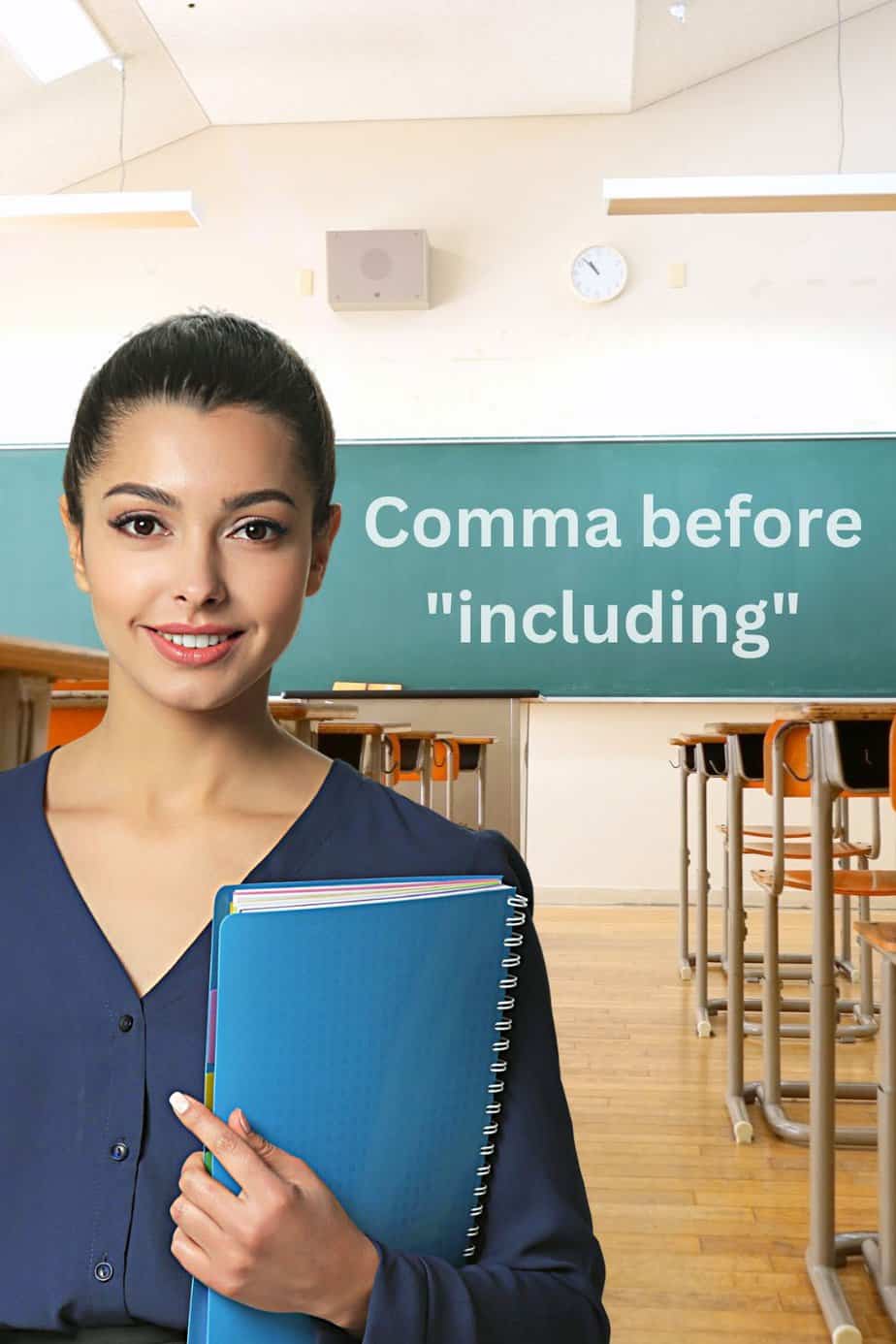Despite a bad reputation as one of the most confusing parts of English grammar, the comma actually follows fairly simple rules.
Chief among them is that the need for commas is primarily determined by the need for clarity.
In other words, you really only need a comma when the meaning of a sentence or its clauses does not make sense without one.
Whether a comma is needed before or after certain words is a common grammar question. This is understandable if you try to memorize set rules for each word.
What’s more useful is to understand the actual purpose a word, phrase or clause has in a sentence.
Once you do this, commas you find will fall into place like expertly arranged dominoes.
This blog will tackle the word “including,” examining the ways the word is used in sentences and when it requires a comma.
Do you need a comma before “including?”
Whether “including” requires a comma will depend on what the word is doing in your sentence. If it is part of a non-restrictive or unessential clause or phrase, you need a comma. On the other hand, if “including” is the start of a phrase that is essential to your sentence’s meaning, you should not add a comma. Although this rule is simple, it can be a bit tricky as the word “including” is ambiguous. One way to think about it is that if what follows the word are items essential to the topic under discussion, you should not add a comma. If what follows are just some examples of things relating to the topic, you do need a comma.
Comma rules for restrictive clauses and phrases
A phrase is a group of words in a sentence that forms a cohesive group or idea. Unlike clauses, which must contain at least a verb and which often include a subject or object, phrases can consist of any group of words.
The words “giant plate of spaghetti” is a phrase, while “I ate the giant plate of spaghetti” is a clause. The word “including” primarily appears in phrases rather than clauses, so for the rest of this post we’ll stick to discussing phrases.
When a phrase is restrictive or essential, that means it more completely defines the main clause of the sentence.
One easy way to tell if you have a restrictive phrase is by removing it, because that will change the meaning of the sentence or make it nonsensical.
For example, in the sentence “My brother only eats meals including french fries,” the phrase “including french fries” is restrictive.
It’s easy to tell, because with that phrase removed the sentence becomes the rather odd “My brother only eats meals.”
Commas before “including” in restrictive phrases

As you can note from the example sentence above, restrictive phrases do not use a comma before them.
If we return to the idea that commas exist to add clarity to a sentence, it’s obvious why: the lack of a comma pulls the eye along the sentence to the end without stopping, so that we know all the ideas it contains are strongly connected.
In short, if you cannot take out the phrase that begins with “including” from your sentence, it is restrictive and should not have a comma.
Examples:
“Alfred’s girlfriend will only go to see movies including vampires.”
“Jennifer hates listening to songs including bagpipes.”
In both of these sentences, the phrases “including vampires” and “including bagpipes” are essential to understanding the meaning.
As with our earlier french fry example, the first sentence here is a bit odd without its restrictive phrase there to tell us what kind of movies Alfred’s girlfriend likes.
Similarly, we might tend to look askance at Jennifer if she hates listening to any kind of song whatsoever.
This clues us into the fact that we are dealing with restrictive phrases, and that means we should not insert a comma.
Examples:
“Jennifer’s favorite singers are all women, including Katy Perry, Taylor Swift and Aretha Franklin.”
“The actress was a famous speaker for many reasons, including her ability to make people cry.”
In these examples, the comma before “including” lets us know what follows is a list of examples that we can safely skip.
In the second sentence, we know that the actress’s ability to make people cry is only one reason she’s a famous speaker.
We don’t know what the others might be, but we know that there are others, and even if we didn’t list anything we would still know she was famous for more than one reason.
Can you imagine the first sentence without the comma? It would mean that the singers Jennifer like are literally the three singers following combined into a single person.
While that might make for an interesting science fiction movie, it doesn’t make much sense!
“Including” or “That Includes”?
It’s worth noting that while they are grammatically correct, sentences with a restrictive phrase and the word “including” look and sound a little odd.
Typically, a restrictive phrase using this word would take the form “that include” (or “that includes” or “that included”) instead of “including.”
Rewritten to match that pattern, our example sentence about bagpipes would look like this: “Jennifer hates listening to songs that include bagpipes.”
While both forms are grammatical, you would be best served to rephrase any sentences that contain a restrictive clause or phrase beginning with “including.”
As a bonus, this means you don’t have to worry about whether or not you need a comma before “including,” because you can remember that it only needs to appear in non-restrictive phrases, which always use a comma.
Comma rules
It seems that there is an endless amount of comma rules.
However, most of the comma questions can actually be solved by simply knowing the most important comma rules.
As a great starting point, make sure to check out our comma rules landing page where you will find tons of useful article to master all aspects of commas and punctuation!
There, you will find super helpful articles about common comma questions and topics such as:
Do you need a comma before and?
Do you need a comma before and in a list?
Do you put a comma before a quote?
and much more!

Frequently asked questions on Comma before including
Should there be a comma before “including”?
A comma before “including” is needed when it introduces information that is not grammatically essential to the rest of the sentence. To warrant a comma, “including” must come after an independent clause that should still make sense even without the idea introduced by “including.”
Does the comma go before or after “including”?
The comma may go before “including” but not after it. The pre-comma would be necessary if and when “including” introduces what we call a parenthetical phrase. A parenthetical phrase is something that introduces grammatically non-essential information. Instead, the phrase only provides additional information that enriches the meaning of the whole sentence.
Is “including” a conjunction?
“Including” is a preposition and not a conjunction. Since it is a preposition, it should only introduce a phrase and not a clause. The preposition “including” is used to provide more context and examples. It suggests that one wants to explain something that is considered part of a whole rather than the whole thing itself.
Can you start a sentence with “including”?
It is grammatically possible to start a sentence with “including.” For example, we can say the following sentences: “Including Bailey, we have three Golden Retrievers at home” and “Including my step-brother, my parents always say they have two children.”

Hey fellow Linguaholics! It’s me, Marcel. I am the proud owner of linguaholic.com. Languages have always been my passion and I have studied Linguistics, Computational Linguistics and Sinology at the University of Zurich. It is my utmost pleasure to share with all of you guys what I know about languages and linguistics in general.

